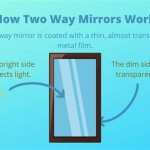Hide My TV Behind a Mirror
Concealing a television within a living space is a growing trend in interior design. This approach allows homeowners to enjoy the benefits of modern technology without sacrificing a room's aesthetic. One popular method for achieving this seamless integration is by concealing the television behind a mirrored surface. This article explores the various facets of this design solution, examining the available options, installation considerations, and the advantages and disadvantages of this increasingly popular approach.
Several types of mirrored TV solutions exist, each catering to different budgets and technical requirements. The most basic option involves a two-way mirror, often referred to as a dielectric mirror, placed in front of a standard television. These mirrors reflect a portion of the light striking their surface while allowing a percentage to pass through, enabling the viewer to see the television screen behind the glass. The effectiveness of this solution depends on the quality of the mirror and the ambient lighting conditions.
A more advanced option involves specialized mirror TV units. These units come pre-assembled with the mirror and TV integrated within a single frame. The mirror glass in these units is specifically designed for optimal television viewing, offering superior clarity and light transmission compared to standard two-way mirrors. These units also often incorporate additional features such as built-in sound systems and customizable frames.
A third alternative utilizes a motorized lift mechanism that raises the television from a concealed compartment when needed and lowers it back down when not in use. This option offers complete concealment when the TV is not being viewed. The lift mechanism can be integrated into existing furniture or custom-built cabinetry, providing a high degree of design flexibility.
Installation methods vary depending on the chosen solution. A simple two-way mirror installation can be a DIY project for those with basic handyman skills, involving mounting the mirror onto a wall or existing frame. However, more complex systems, such as integrated mirror TV units and motorized lifts, generally require professional installation. These systems necessitate careful wiring, precise measurements, and potentially structural modifications to accommodate the equipment.
Choosing the right location for a mirrored TV is crucial. Factors to consider include the viewing angle, ambient lighting, and the size of the room. Excessive natural light or bright artificial lighting can wash out the television image reflected in the mirror. Careful consideration of the room's layout is necessary to ensure optimal viewing conditions.
The benefits of concealing a television behind a mirror are numerous. Aesthetics are a primary driver for this design choice. By disguising the television as a decorative mirror, the technology becomes less intrusive, preserving the room's décor and avoiding the "black box" effect. This is particularly beneficial in rooms where a prominent television might clash with the overall design aesthetic, such as formal living rooms, bedrooms, or dining areas.
Furthermore, a mirrored TV can contribute to a sense of spaciousness. The reflective surface of the mirror can visually enlarge a room, making it appear brighter and more open. This is especially advantageous in smaller spaces where a large television might otherwise dominate the room.
However, this design approach also presents some potential drawbacks. Cost is a primary consideration. Specialized mirror TV units and motorized lift systems can represent a significant investment compared to a standard television. Two-way mirrors, while more affordable, can compromise image quality, particularly in brightly lit environments.
Image quality can also be affected by the technology itself. Even with high-quality mirrored glass, some degree of light reflection will always occur, potentially impacting the clarity and brightness of the displayed image. This effect can be minimized by controlling ambient lighting and choosing a high-quality mirror specifically designed for television viewing.
Maintenance and cleaning can also present challenges. Cleaning a mirrored TV requires specialized cleaning solutions and techniques to avoid damaging the delicate electronic components. Dust and fingerprints are more visible on mirrored surfaces, necessitating more frequent cleaning compared to standard televisions.
Technological advancements are constantly improving the performance and affordability of mirrored TV solutions. Innovations in mirror technology and display technology are leading to enhanced image quality, reduced glare, and thinner profiles. As the technology evolves, this design solution is becoming increasingly accessible and practical for a wider range of applications.
Careful planning and consideration are crucial when implementing a mirrored TV solution. Understanding the available options, installation requirements, advantages, and potential drawbacks will ensure a successful integration into any living space. By carefully evaluating these factors, homeowners can effectively leverage this innovative approach to seamlessly blend technology with their interior design vision.

Television Framed Frameless Dielectric Mirror Tv

The Living Room Tv As We Know It Is Over Laurel Home

Hide My Tv Home Of Solutions

Television Framed Frameless Dielectric Mirror Tv

Tv Coverups Hide Your With Art Or A Frame Mirror Framed

29 Creative Modern Ways To Hide A Tv Digsdigs

Hide Your Tv Behind This Magic Mirror The Gadgeteer

Television Framed Frameless Dielectric Mirror Tv

7 Super Smart And Stylish Ways To Hide Your Tv

15 Brilliant Ways To Hide Your Tv Like A Professional Designer








